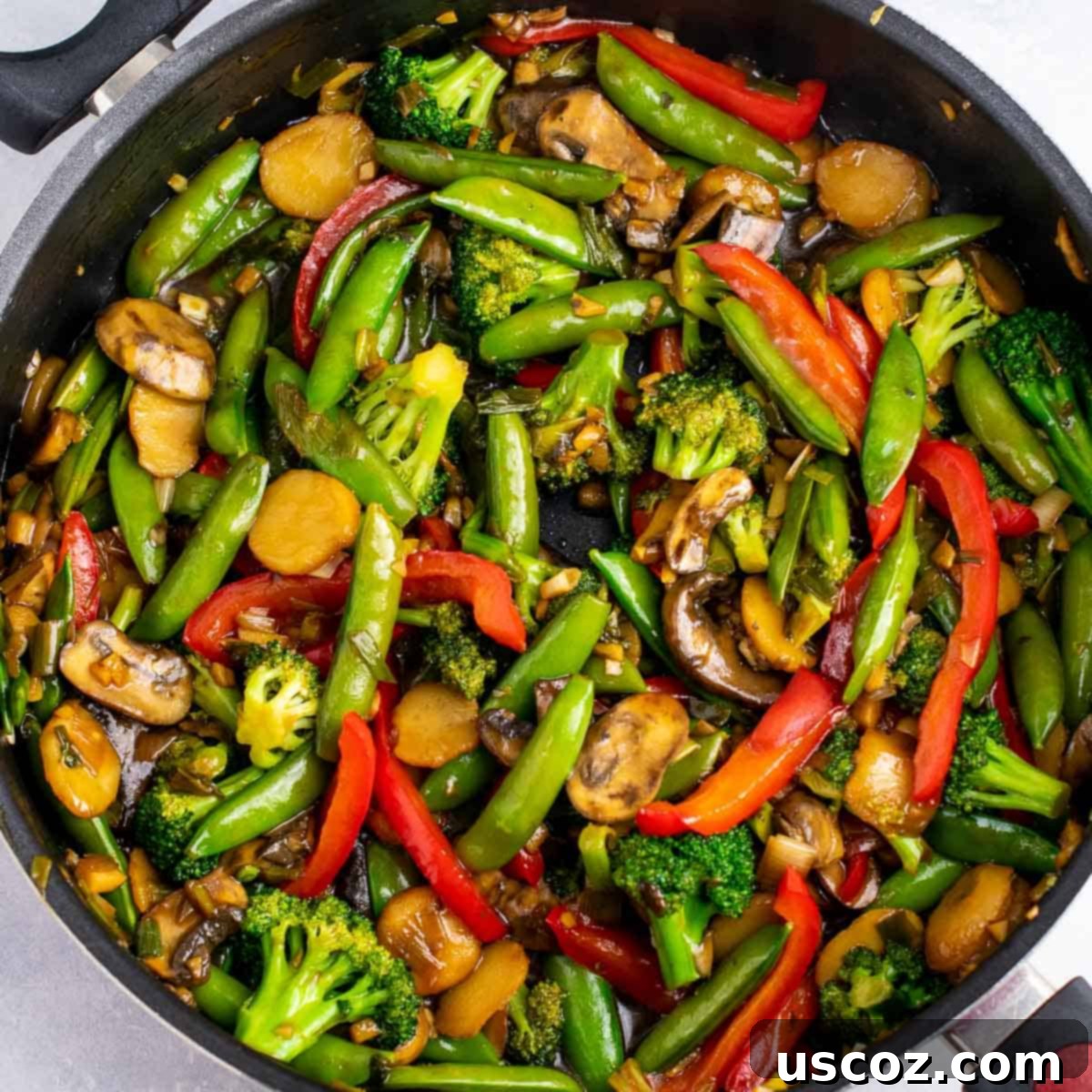Ultimate Homemade Stir Fry Veggies with Garlic Sauce: Easy Takeout Style Recipe
These Stir Fry Veggies in homemade garlic sauce are absolutely delicious, vibrant, and packed with flavor! Skip the takeout and create an authentic, restaurant-quality vegetable stir fry in your own kitchen in minutes with this easy-to-follow recipe. Perfect as a satisfying main dish or a flavorful side.
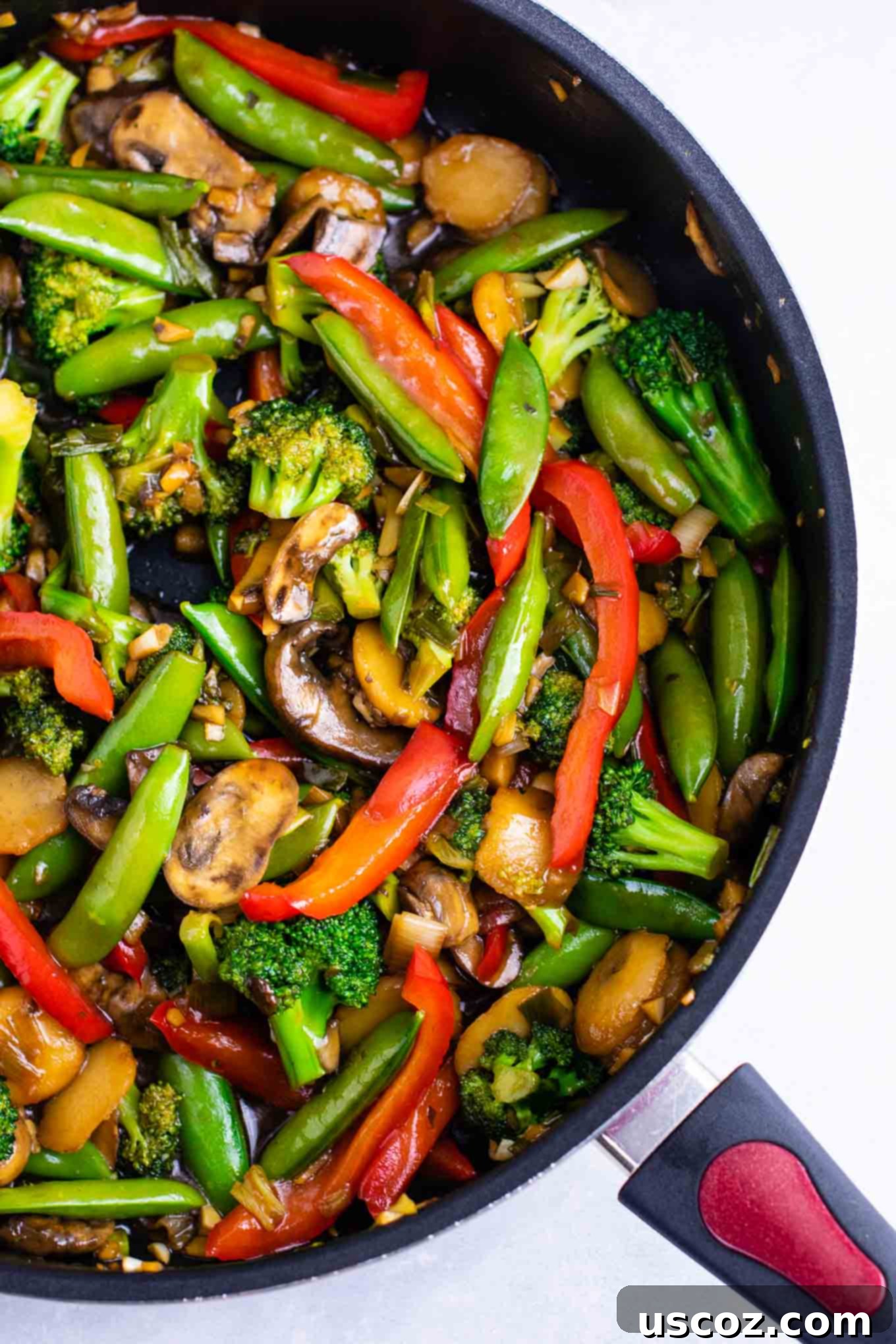
Why You Will Love These Homemade Stir Fry Veggies!
Stir-fry veggies are a universally loved dish, and for good reason! This particular recipe is a foolproof way to bring the authentic flavors of your favorite Asian takeout right to your dinner table. Whether you’re aiming for a light lunch, a satisfying main course, or a vibrant side dish, this recipe is guaranteed to be a hit with everyone. The vibrant rainbow of fresh vegetables combined with our simple yet incredibly flavorful homemade garlic sauce makes this dish not only delicious but also visually appealing and incredibly easy to prepare.
Forget complicated ingredient lists or obscure sauces. We focus on fresh, accessible produce and an effortless 3-ingredient stir fry sauce that truly transforms everyday vegetables into something extraordinary. Paired with our Teriyaki Vegetables, you’ll have all your favorite Asian-inspired dishes mastered at home!
This stir fry vegetable recipe is truly fool-proof and rivals any takeout option you might consider. It’s an ideal choice for busy weeknights when you crave something wholesome yet quick and bursting with flavor. The beauty of this recipe lies in its simplicity and the way it celebrates fresh ingredients.
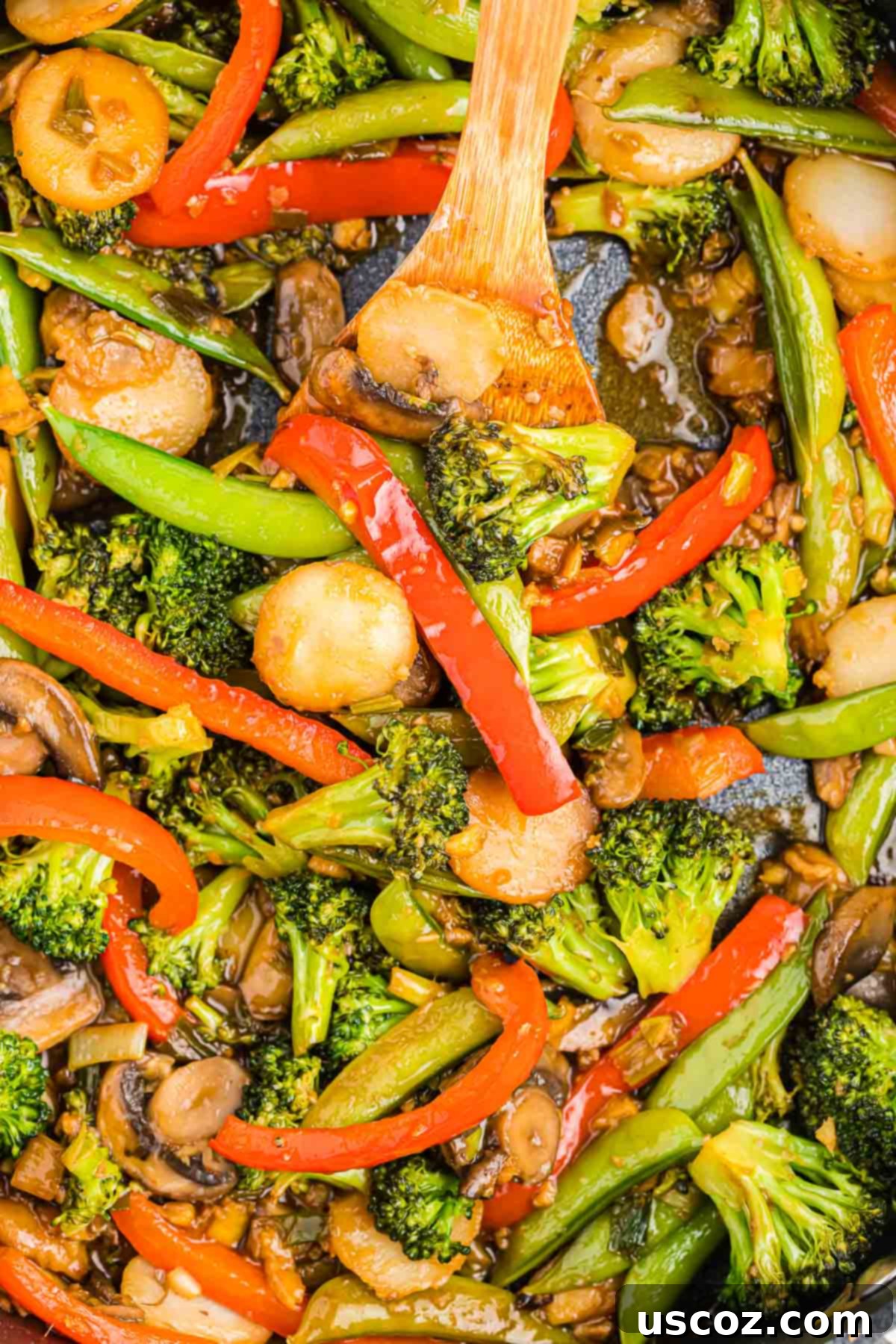
You can find the full recipe and detailed instructions at the bottom of this post, but let’s first dive into the essential ingredients that make this veggie stir fry so special. Our carefully selected combination of vegetables ensures a delightful mix of textures and flavors, all brought together by that irresistible homemade sauce.
Key Ingredients for the Perfect Stir Fry Veggies
To create this sensational stir fry, you’ll need a selection of fresh vegetables and a few pantry staples for our signature sauce. Each ingredient plays a crucial role in building the layered flavors and appealing textures of the dish:
- Water Chestnuts: These canned gems add an irresistible crisp texture, a signature element of classic stir fries.
- Sugar Snap Peas: Offering a sweet crunch and vibrant green color.
- Mushrooms: Earthy and savory, mushrooms absorb the sauce beautifully. Any variety like cremini or shiitake works well.
- Red Bell Pepper: Provides a pop of color, natural sweetness, and a tender-crisp bite.
- Green Onions: Both the white and green parts contribute a mild, fresh onion flavor and a visual garnish.
- Broccoli: A classic stir-fry vegetable, offering a robust texture and nutritional value.
- Garlic: Freshly minced garlic is absolutely essential for that aromatic, savory base.
- Ginger: Freshly minced ginger adds a warm, zesty, and slightly spicy kick that brightens the entire dish.
- Soy Sauce: The foundation of our savory sauce, providing umami and saltiness.
- Corn Starch: Used as a thickener to give the sauce its perfect glossy, clingy consistency.
- Sesame Oil: Adds a distinct nutty aroma and flavor, used for both cooking and in the sauce.
This combination ensures a balanced and delicious stir fry that’s both satisfying and light.
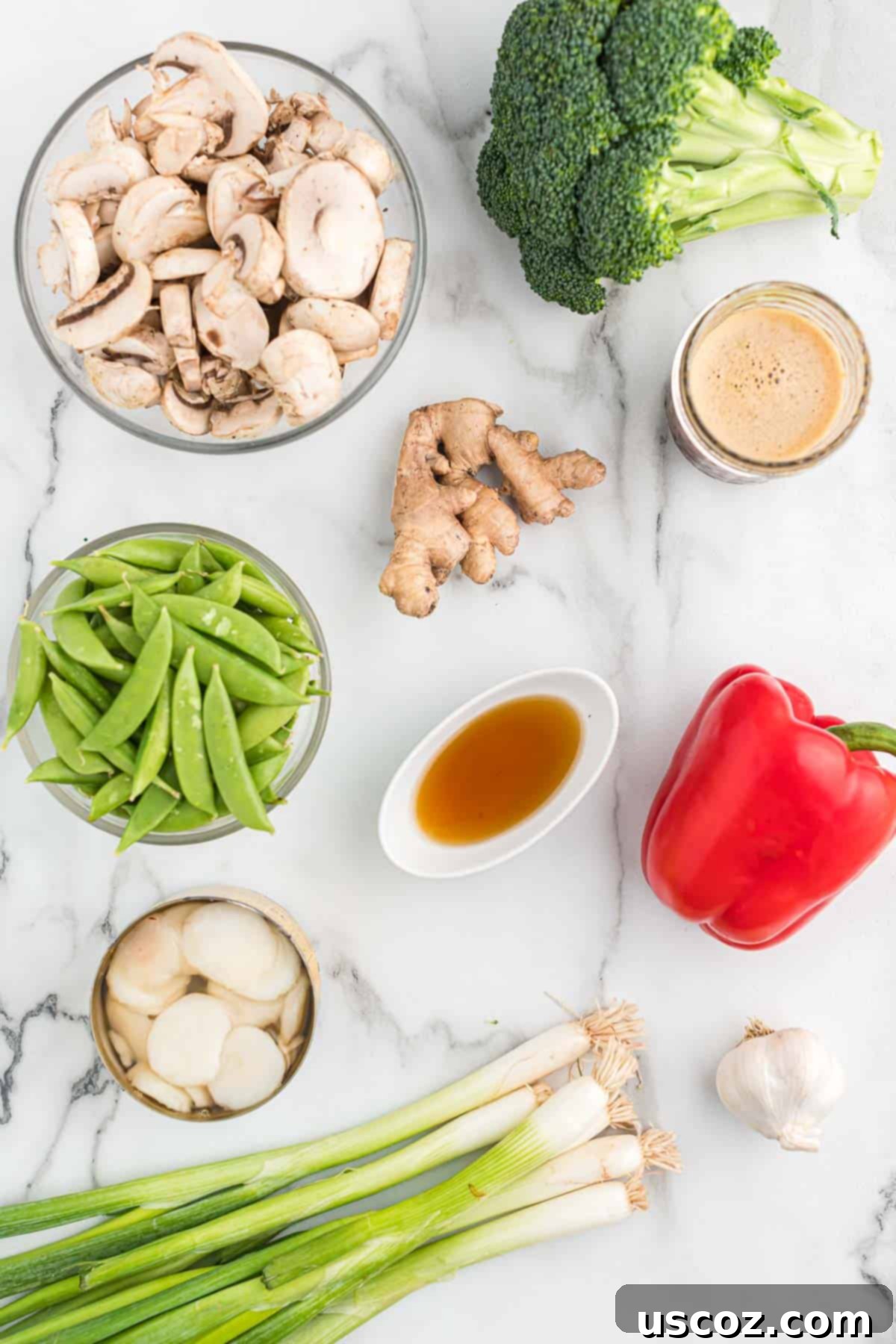
Customizing Your Stir Fry: Smart Substitutions & Additions
One of the best aspects of stir frying is its incredible flexibility. This recipe is a fantastic way to use up fresh produce you already have on hand, making it perfect for minimizing food waste and adapting to your preferences.
- Onion: While green onions offer a delicate flavor, you can absolutely substitute them with yellow, white, or red onion. Just remember to slice them thinly and add them early in the cooking process as they take a bit longer to soften.
- Peppers: Feel free to use any color of bell pepper – green, yellow, or orange will work wonderfully and add different hues to your colorful dish. For a touch of heat, a sliced jalapeño or serrano pepper can be a great addition.
- Other Vegetables: The possibilities are endless! Don’t hesitate to incorporate other crunchy or tender vegetables. Great options include:
- **Carrots:** Sliced into matchsticks or thin rounds for sweetness and color.
- **Cauliflower or Green Beans:** Cut into bite-sized florets or trimmed for a hearty addition.
- **Baby Corn or Bok Choy:** Adds an authentic Asian touch and unique textures.
- **Cabbage, Zucchini, or Asparagus:** These cook relatively quickly and blend well with the existing flavors.
- **Snow Peas:** Similar to sugar snap peas but with a flatter pod, offering a slightly different texture.
A note on frozen vegetables: While convenient, we highly recommend sticking to fresh vegetables for stir fry. Frozen veggies tend to release a lot of water when cooked, which can make your stir fry soggy rather than crisp, and the texture simply isn’t the same. Fresh is always best for that perfect tender-crisp result!
To transform this delicious side into a complete, satisfying meal, consider adding your favorite protein. This recipe pairs wonderfully with:
- Chickpeas: A fantastic plant-based protein source that adds a tender bite.
- Tofu: Extra-firm tofu, pressed and cubed, stir-fries beautifully and absorbs the sauce.
- Chicken or Beef: Thinly sliced chicken breast or thigh, or strips of beef, can be added and stir-fried until cooked through before adding the vegetables.
- Shrimp: Quick-cooking shrimp are an excellent choice for a seafood stir fry.
- Other Vegetarian Meat Substitutes: Many plant-based alternatives can be easily incorporated.
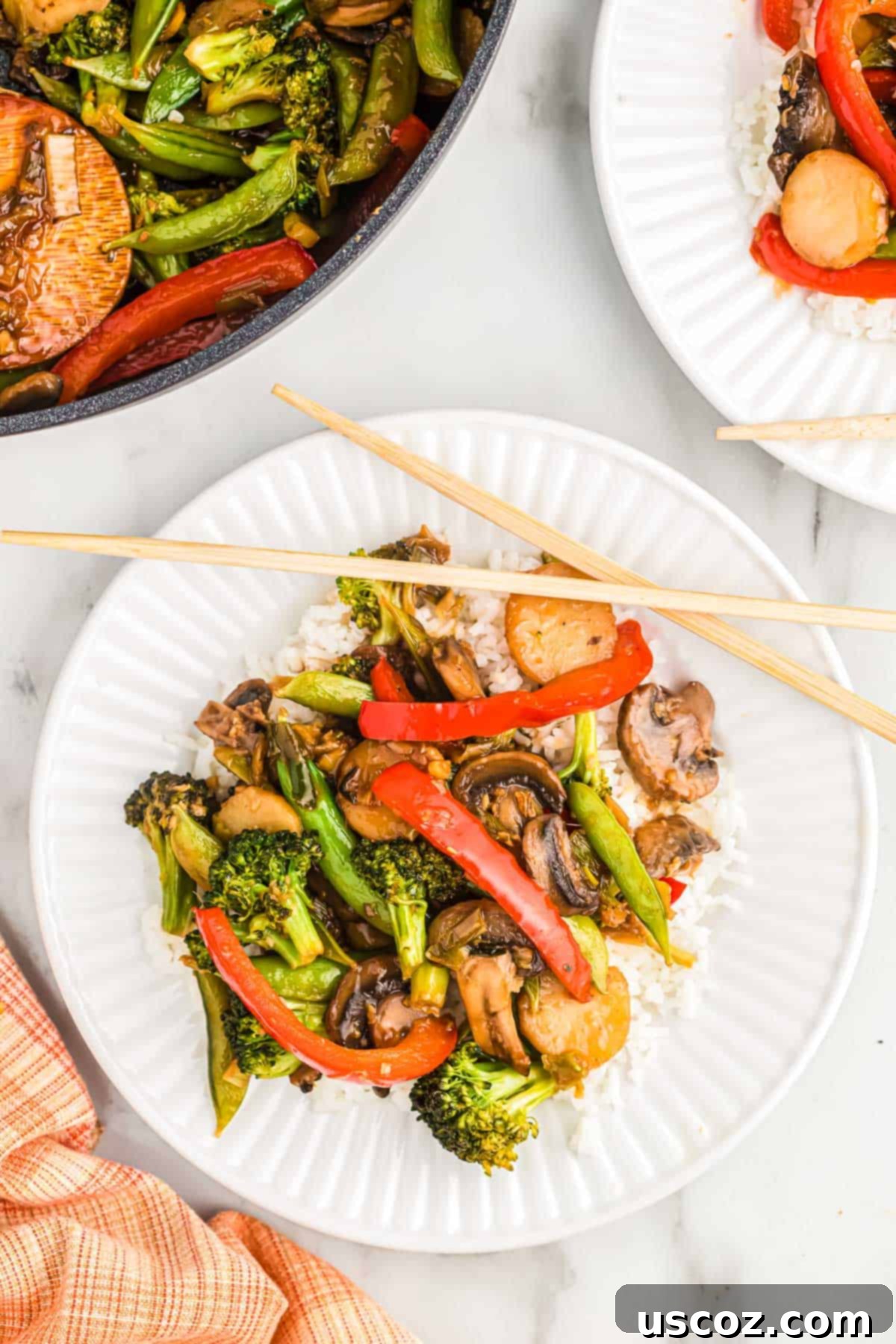
Mastering the Art of Stir Frying: Step-by-Step Guide
Creating a perfect stir fry is all about technique and timing. Follow these steps to achieve tender-crisp vegetables coated in a rich, flavorful sauce:
Step 1: Prepare Your Ingredients and Heat the Pan
Before you begin cooking, ensure all your vegetables are chopped and your garlic and ginger are minced. Stir-frying is a fast-paced cooking method, so having everything ready (mise en place) is crucial. Add 1 tablespoon of sesame oil to a large skillet, wok, or jumbo cooker. Heat it over medium-high heat. You want the pan to be hot enough to sizzle the vegetables, but not so hot that it burns the oil. If adding protein like chicken or tofu, cook it first until browned and then set aside before adding vegetables, or simply push it to one side of the pan if your pan is large enough.
Step 2: Stir Fry the Vegetables to Perfection
Add the water chestnuts, sugar snap peas, mushrooms, bell pepper, green onions, broccoli, minced garlic, and minced ginger to the hot pan. Stir fry the vegetables for 20 – 25 minutes, stirring frequently. The goal here is to cook the vegetables until most of their liquid has evaporated, they are tender-crisp, and slightly browned in places, but not soft or mushy. The texture is paramount in stir-frying – we want a pleasant bite, not an overcooked softness.
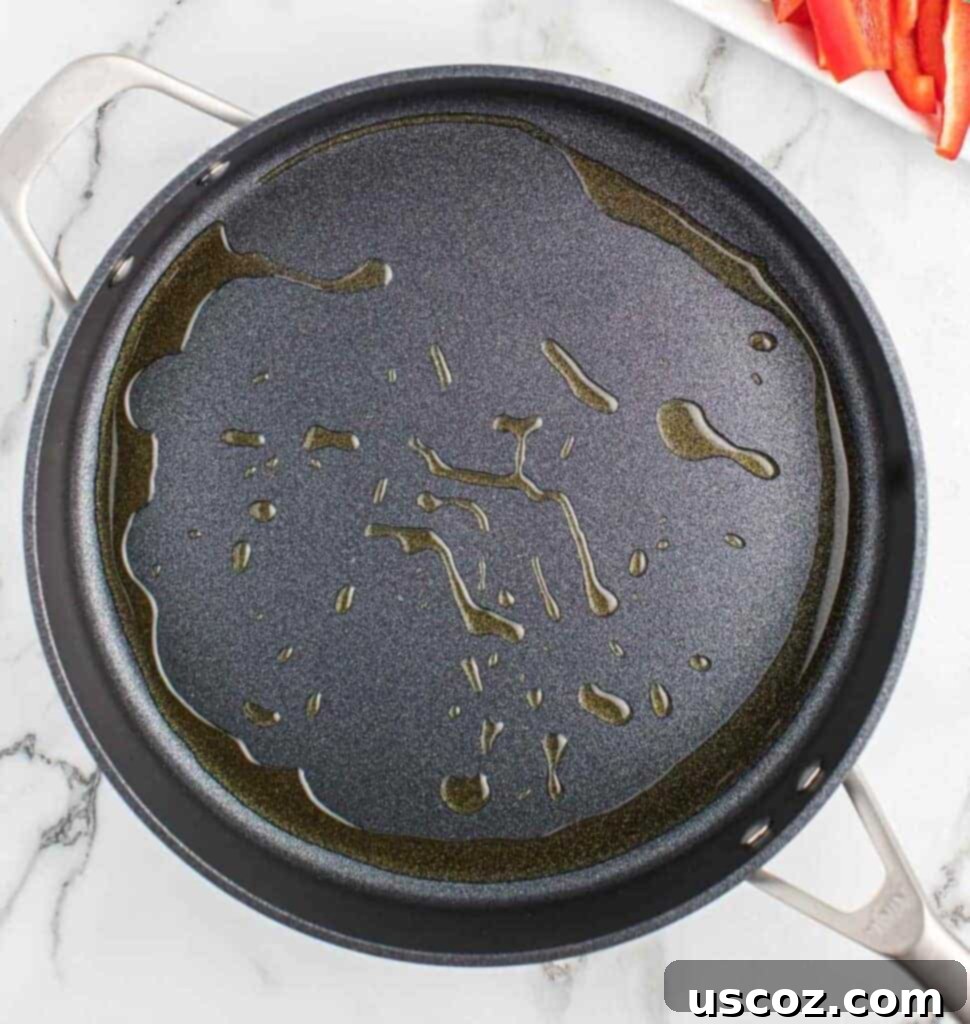
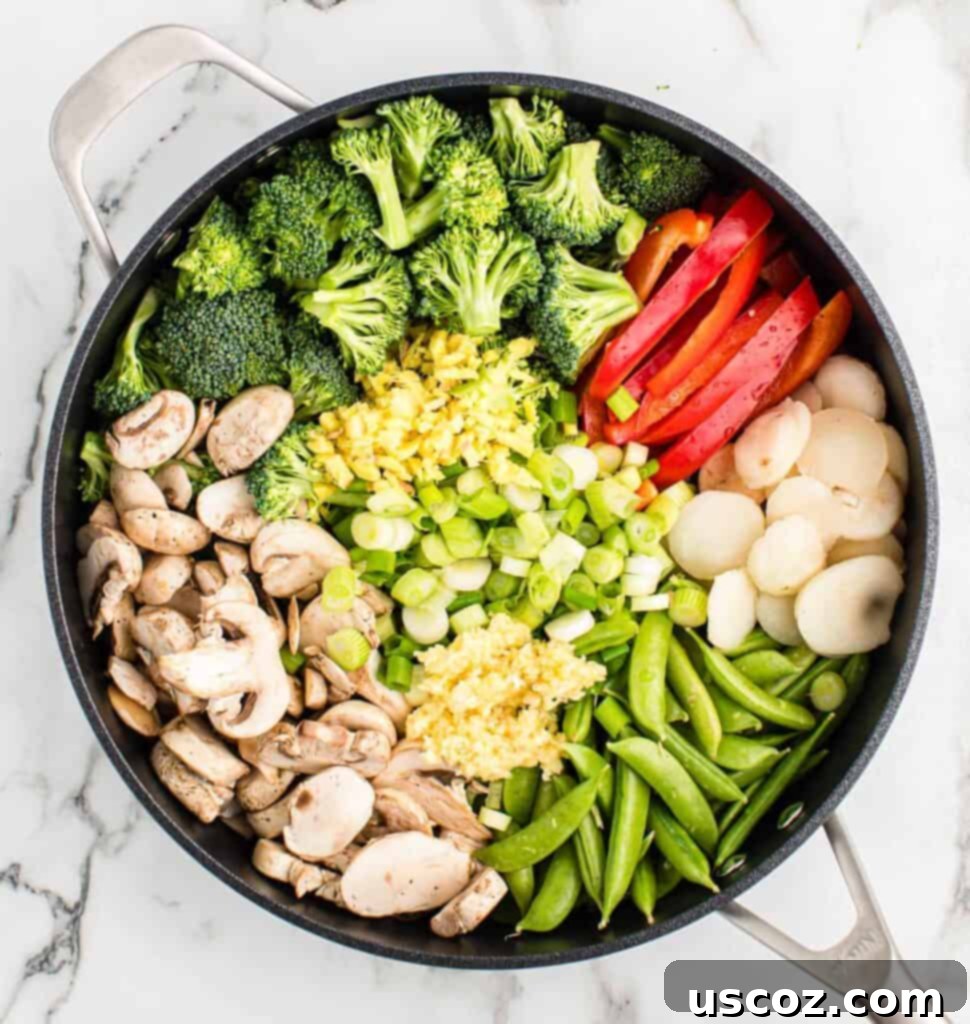
Step 3: Prepare the Homemade Stir Fry Sauce
While the vegetables are cooking, quickly prepare your homemade stir fry sauce. Simply combine the soy sauce, corn starch, and any other secret ingredients (as outlined in the recipe card below) in a mason jar or small bowl. Shake or whisk vigorously until all ingredients are well combined and the corn starch has dissolved. This easy, 3-ingredient sauce is truly a game-changer for its simplicity and incredible flavor!
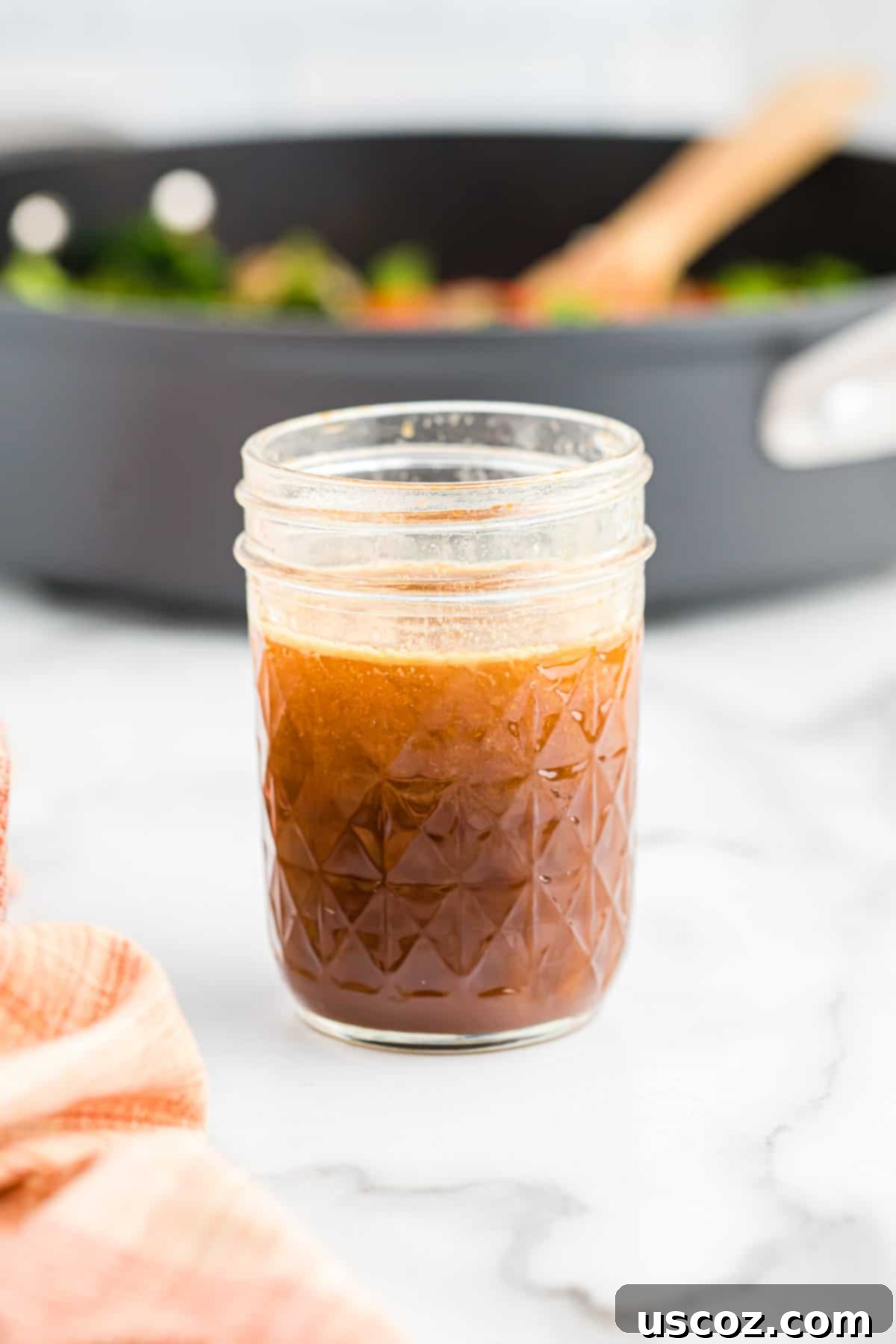
Step 4: Combine and Serve
Once your vegetables have reached the desired texture, pour the prepared stir fry sauce over them. Cook for an additional 3 – 5 minutes, stirring frequently, until the sauce thickens to a glossy consistency and beautifully coats all the vegetables. If you set aside any cooked protein, now is the time to add it back to the pan and toss to combine. Serve immediately, either alone for a low-carb option or over fluffy white rice, nutty brown rice, or your favorite noodles for a complete and delicious meal or side dish.
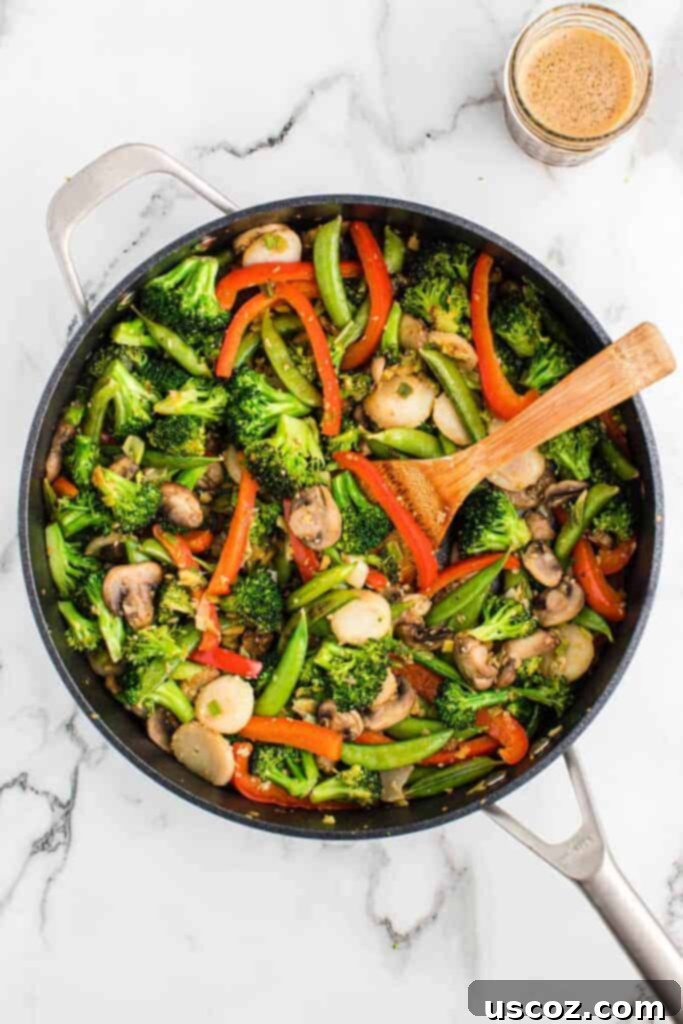
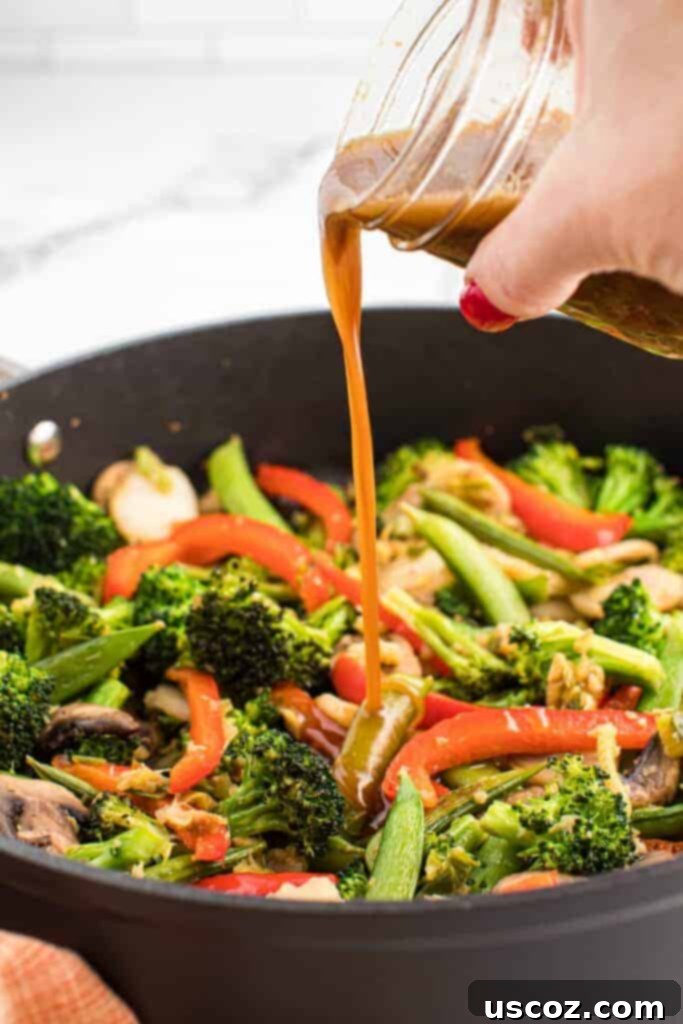
This recipe includes some of the best stir fry vegetables, chosen for their complementary flavors and textures:
- Water chestnuts: For that irresistible crunch.
- Sugar snap peas: Adding sweetness and a snappy texture.
- Mushrooms: Bringing an umami depth and soft chew.
- Bell peppers: For vibrant color and a sweet, crisp element.
- Green onions: Providing a mild oniony bite and freshness.
- Broccoli: A hearty and nutrient-rich staple.
- Garlic: The pungent backbone of countless Asian dishes.
- Ginger: Offering a fresh, spicy, and aromatic kick.
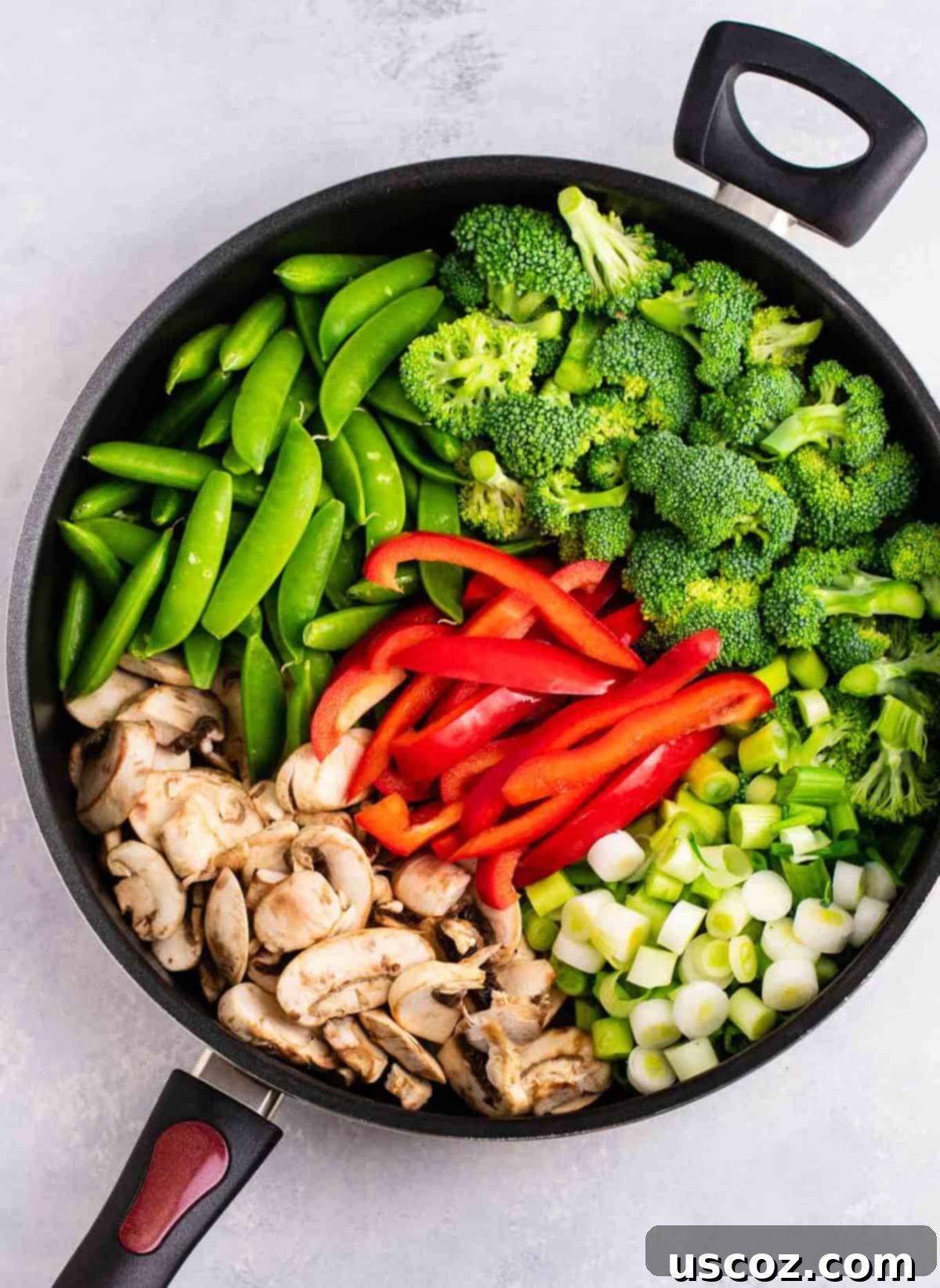
All of these vegetables pair beautifully, creating a harmonious blend that perfectly complements the richness of the stir fry sauce. Freshly minced garlic and ginger are the aromatic heart of this dish, tying together all those wonderful oriental flavors.
Never used fresh ginger before? Don’t be intimidated! It’s much easier than you think. You can find fresh ginger at almost any grocery store in the produce section. To prepare it, simply scrape off the thin skin using the edge of a spoon or a vegetable peeler, then finely dice it just as you would garlic. The difference in flavor from powdered ginger is truly remarkable and worth the extra minute of prep!
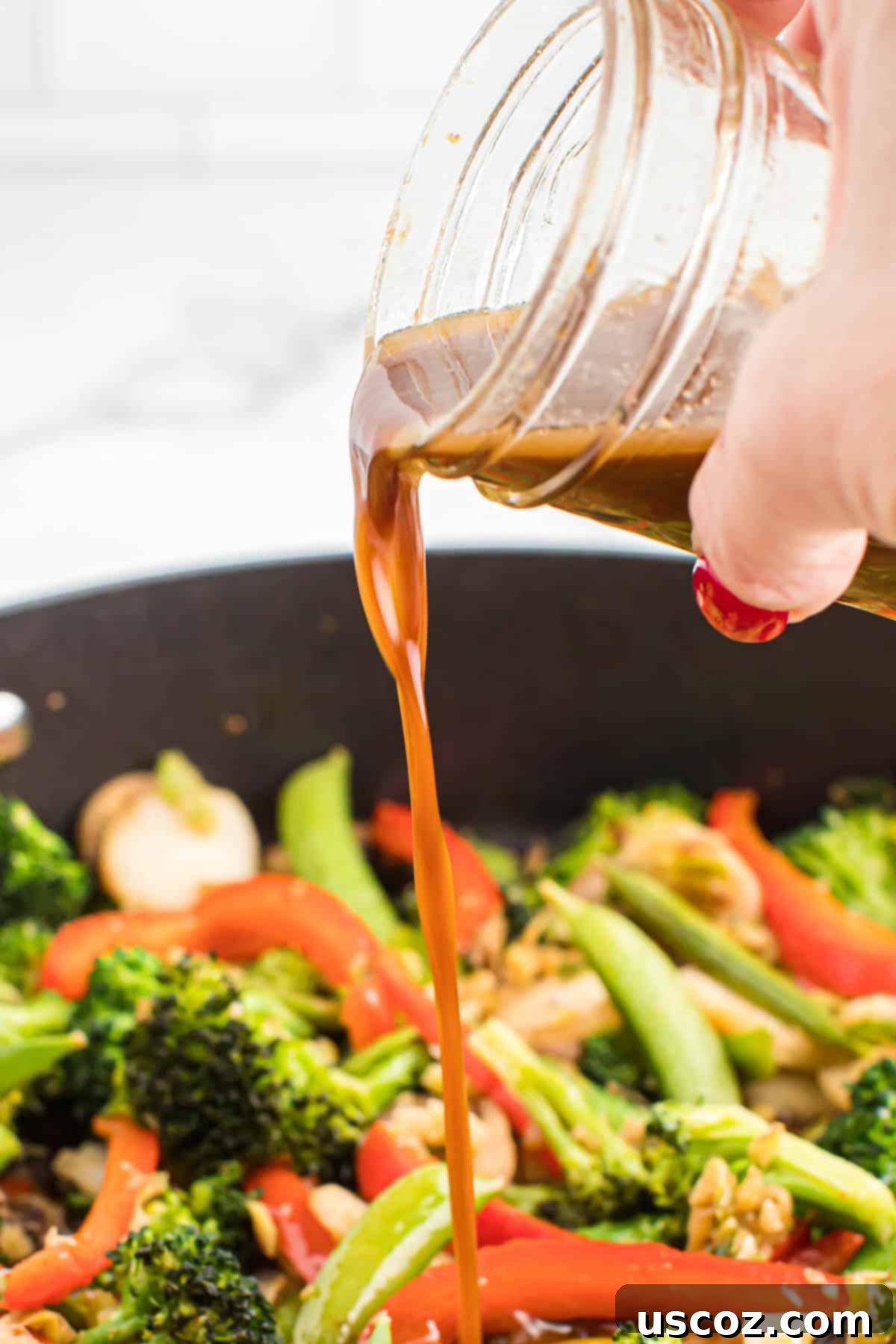
This carefully selected array of vegetables ensures a delightful variety of textures, from the crispness of water chestnuts and sugar snap peas to the tender bite of broccoli and bell peppers, all combining for a truly delicious and satisfying outcome.
Why Our 3-Ingredient Stir Fry Sauce is a Game Changer
For this outstanding stir fry vegetables recipe, we rely on a homemade stir fry sauce that has become a staple in our kitchen for all stir fry dishes. It’s incredibly simple, contains no long list of obscure ingredients, and delivers incredible flavor every single time!
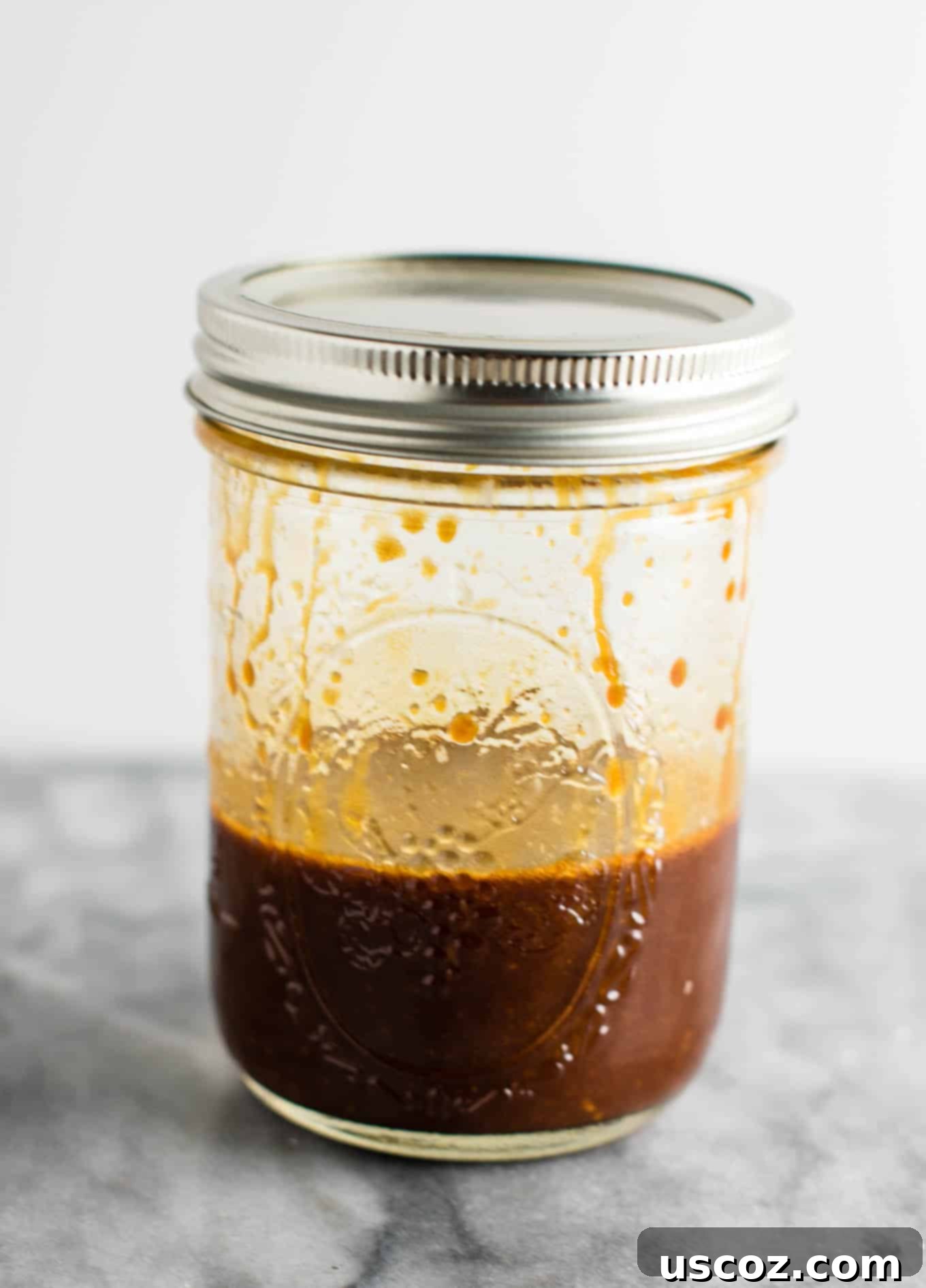
The magic of this sauce truly shines when combined with fresh garlic and ginger, as we do in this recipe. The cornstarch gives it that perfect thick, glossy coating that clings to every piece of vegetable, delivering a burst of savory, slightly sweet, and aromatic flavor in every bite. This simple sauce ensures that your homemade stir fry will taste authentic and satisfying, just like your favorite restaurant version.
Discovering this incredibly easy and delicious sauce completely transformed our stir-fry game! We now enjoy homemade stir-fries far more often, knowing we can achieve restaurant-quality results with minimal effort. For more details on achieving the perfect sauce consistency, you can read my detailed post on how to thicken stir fry sauce? It explains exactly why this simple sauce is the ideal choice for all your homemade stir-fry creations.
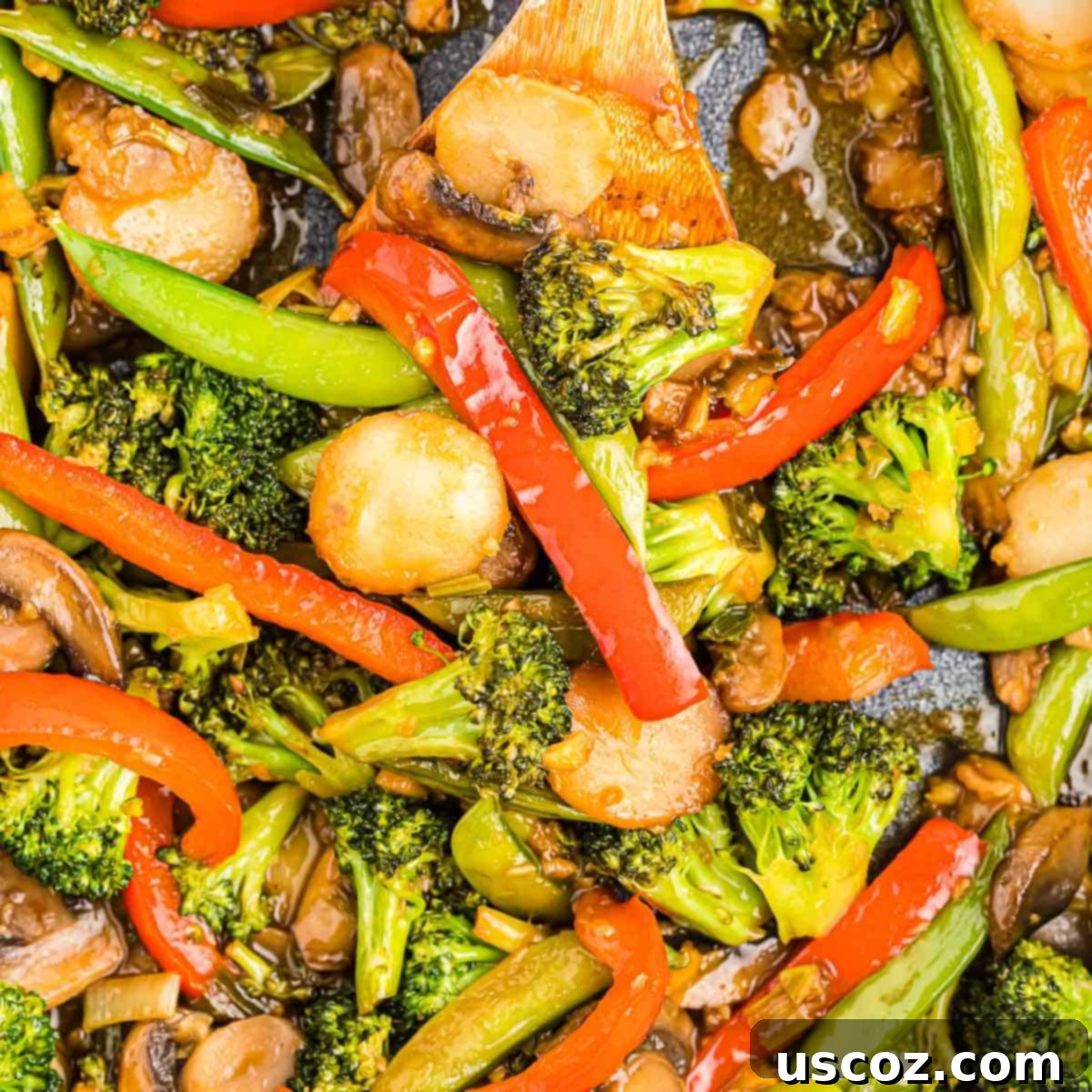
Serving Suggestions for Your Perfect Stir Fry
Once your delectable vegetable stir fry is ready, the serving possibilities are endless! Here are some popular and delicious ways to enjoy your homemade creation:
- To make low carb: Serve your stir fry over cauliflower rice for a lighter, grain-free option, or with low-carb noodles like konjac noodles or zucchini noodles.
- Rice:
- White rice: A classic and comforting base that soaks up all the delicious sauce.
- Brown rice: Offers a nutty flavor and added fiber for a healthier meal.
- Noodles:
- Brown rice noodles: A gluten-free and wholesome choice.
- Lo mein noodles: Thick, chewy wheat noodles perfect for stir-frying with the sauce.
- Ramen noodles: Instant ramen noodles (without the seasoning packet) can be quickly boiled and added for a quick meal.
- Soba noodles: Japanese buckwheat noodles, providing a distinct flavor.
- Quinoa: For a protein-packed, gluten-free alternative to rice, quinoa makes an excellent base. Other grains like farro or couscous can also be used.
- Protein of choice (optional): As mentioned earlier, enhance your meal by adding your favorite protein. Tofu, chickpeas, chicken, beef, or shrimp integrate seamlessly and make for a heartier dish.
- Garnishes: A sprinkle of sesame seeds, fresh cilantro, or a drizzle of chili oil can elevate the presentation and add extra flavor.
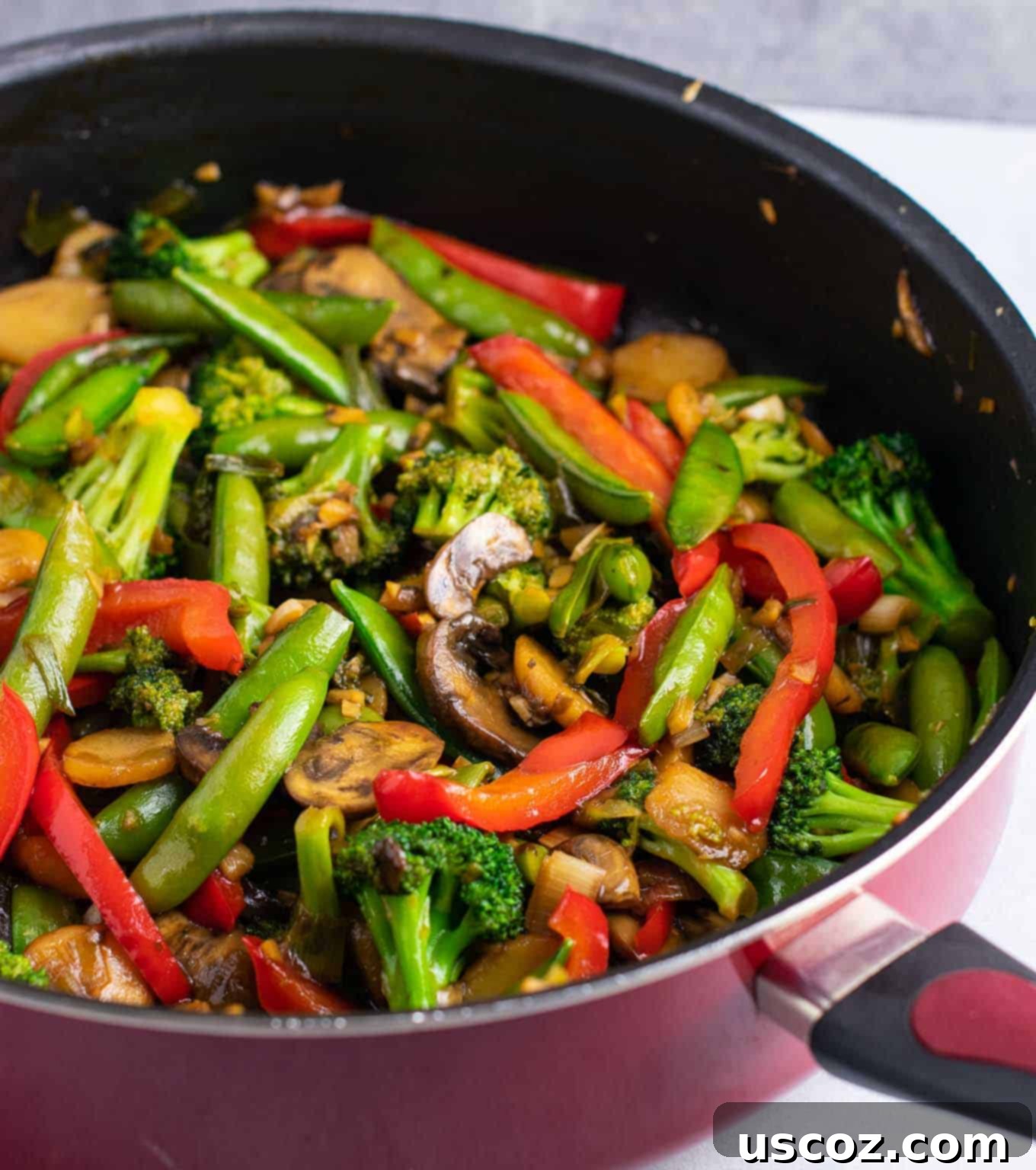
Expert Tips for a Restaurant-Quality Stir Fry at Home
Achieving a perfectly cooked stir fry with tender-crisp vegetables and a glistening sauce is easier than you think with these expert tips:
- Use a Large Pan or Wok: Overcrowding your pan is the biggest mistake you can make. Use the largest skillet or wok you have to ensure the vegetables have enough space to stir fry and brown, rather than steam. This is key for that desirable tender-crisp texture.
- Don’t Overcook Your Vegetables: Stir fry vegetables just long enough to where they are cooked through but still have a slight bite – we call this “tender-crisp” or “al dente.” Overcooked vegetables become mushy and lose their vibrant color and fresh taste.
- Mise en Place (Prepare Everything First): Stir-frying is a very fast cooking method. Have all your vegetables chopped, garlic and ginger minced, and the sauce mixed and ready to go *before* you even turn on the stove. This prevents burning and ensures a smooth cooking process.
- High Heat is Key: Authentic stir-frying uses high heat to cook ingredients quickly, locking in flavors and creating a slight char. Ensure your pan is properly heated before adding ingredients, and don’t be afraid of the sizzle!
- Don’t Skimp on the Aromatics: Fresh garlic and ginger are the heart and soul of stir-fry flavor. Their pungent, warm notes are crucial for that authentic taste. Also, make sure to use the specific 3-ingredient stir fry sauce recipe provided for the best and most balanced flavor.
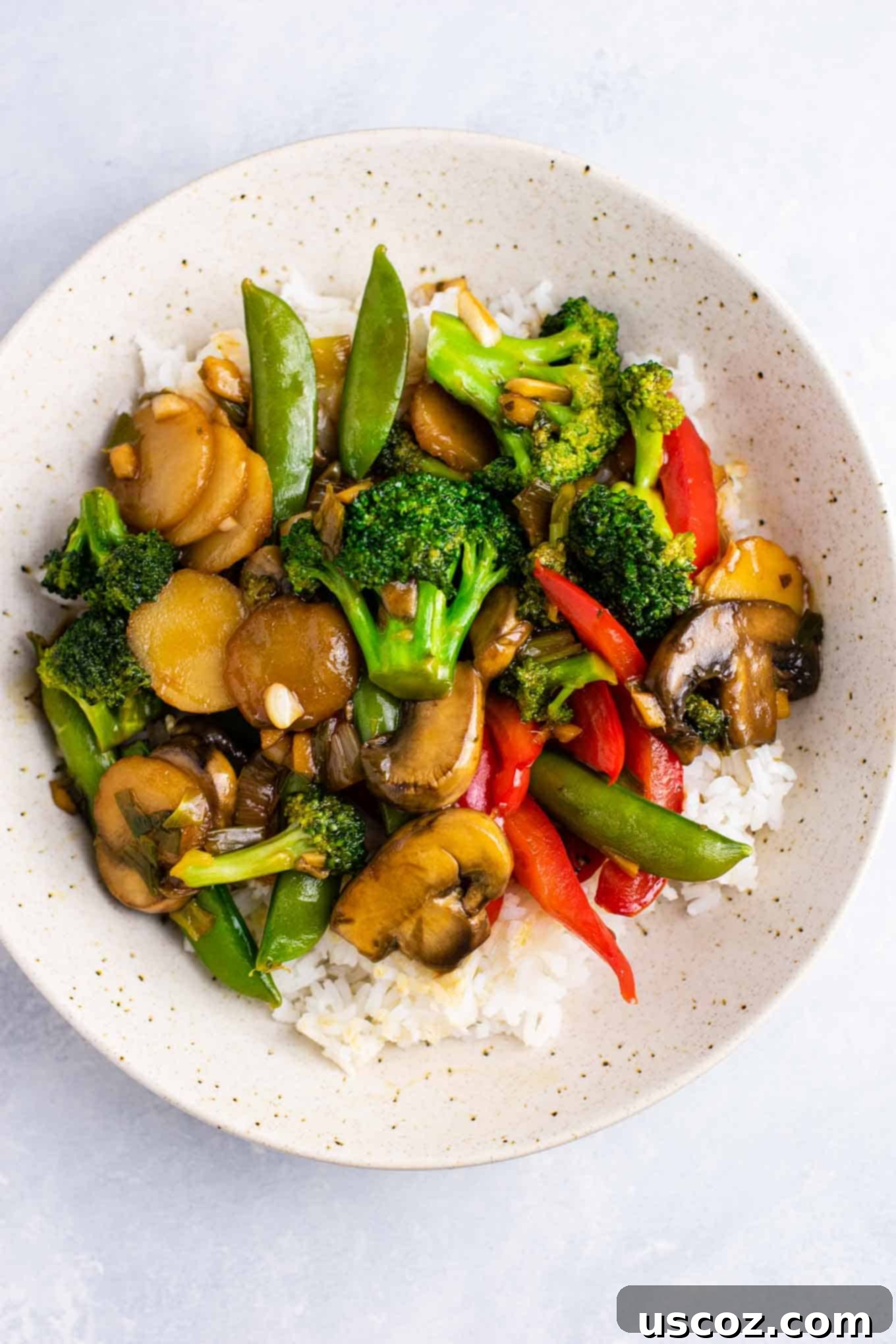
Vegetable Stir Fry FAQs
What Adds Flavor to Stir-Fry?
The delicious complexity of stir-fry flavor comes from a combination of fresh aromatics and key pantry ingredients:
- Soy Sauce: A non-negotiable staple, soy sauce (or tamari for gluten-free) provides the salty, umami-rich base for most stir-fry sauces. It’s the primary flavor driver.
- Sesame Oil: Toasted sesame oil, in particular, adds a distinctive nutty, earthy aroma and flavor. It’s often used in small amounts for finishing or as part of the cooking oil blend.
- Fresh Garlic: Minced garlic is one of the foundational aromatics, offering a pungent, savory depth that is instantly recognizable and deeply satisfying.
- Fresh Ginger: Complementing garlic, fresh ginger (peeled and minced) provides a warm, zesty, and slightly spicy kick that brightens the entire dish and adds a characteristic Asian flair.
- Other Aromatics: Ingredients like green onions, chili flakes (for heat), or a touch of rice vinegar (for acidity) can further enhance the flavor profile.
What veggies go first in a stir-fry?
The key to evenly cooked stir-fry vegetables is to add them to the pan based on their cooking time. Generally, harder, denser vegetables that take longer to cook go in first, followed by quicker-cooking, more tender ones.
- Longer Cooking Vegetables (Add First): Carrots (sliced thin), broccoli florets, cauliflower florets, bell peppers, asparagus, and hardier leafy greens like kale (if using). If you’re using yellow, white, or red onions, add these early.
- Medium Cooking Vegetables (Add Second): Sugar snap peas, green beans, and mushrooms. These typically need a bit less time to become tender-crisp.
- Quick Cooking Vegetables & Aromatics (Add Last): Water chestnuts (which are often pre-cooked), green onions (especially the green parts), minced garlic, and minced ginger. These cook very quickly and can burn easily, so they are added towards the end to preserve their flavor and texture.
For this specific recipe, we’ve carefully selected vegetables that generally cook at a similar rate, allowing you to add most of them together, simplifying the process. However, always keep an eye on texture and adjust cooking times as needed.
Can I Meal Prep Stir Fry Veggies?
Absolutely! Stir-fried vegetables are excellent for meal prepping. You can chop all your vegetables ahead of time and store them in airtight containers in the refrigerator for 3-4 days. You can also mix your stir-fry sauce ingredients (excluding cornstarch until just before cooking, or mixing all together if using within a day) and store separately. When ready to eat, simply stir-fry and enjoy!
How to Store Leftovers?
Store any leftover stir fry in an airtight container in the refrigerator for up to 3-4 days. Reheat gently in a skillet over medium heat or in the microwave until warmed through. Be careful not to overcook when reheating, to maintain the vegetable texture.
Is This Recipe Healthy?
Yes, this vegetable stir fry recipe is incredibly healthy! It’s packed with nutrient-dense fresh vegetables, offering a good source of vitamins, minerals, and fiber. With a relatively low calorie count and options for lean protein additions and low-carb serving methods, it’s a wholesome and balanced meal choice for nearly any diet.
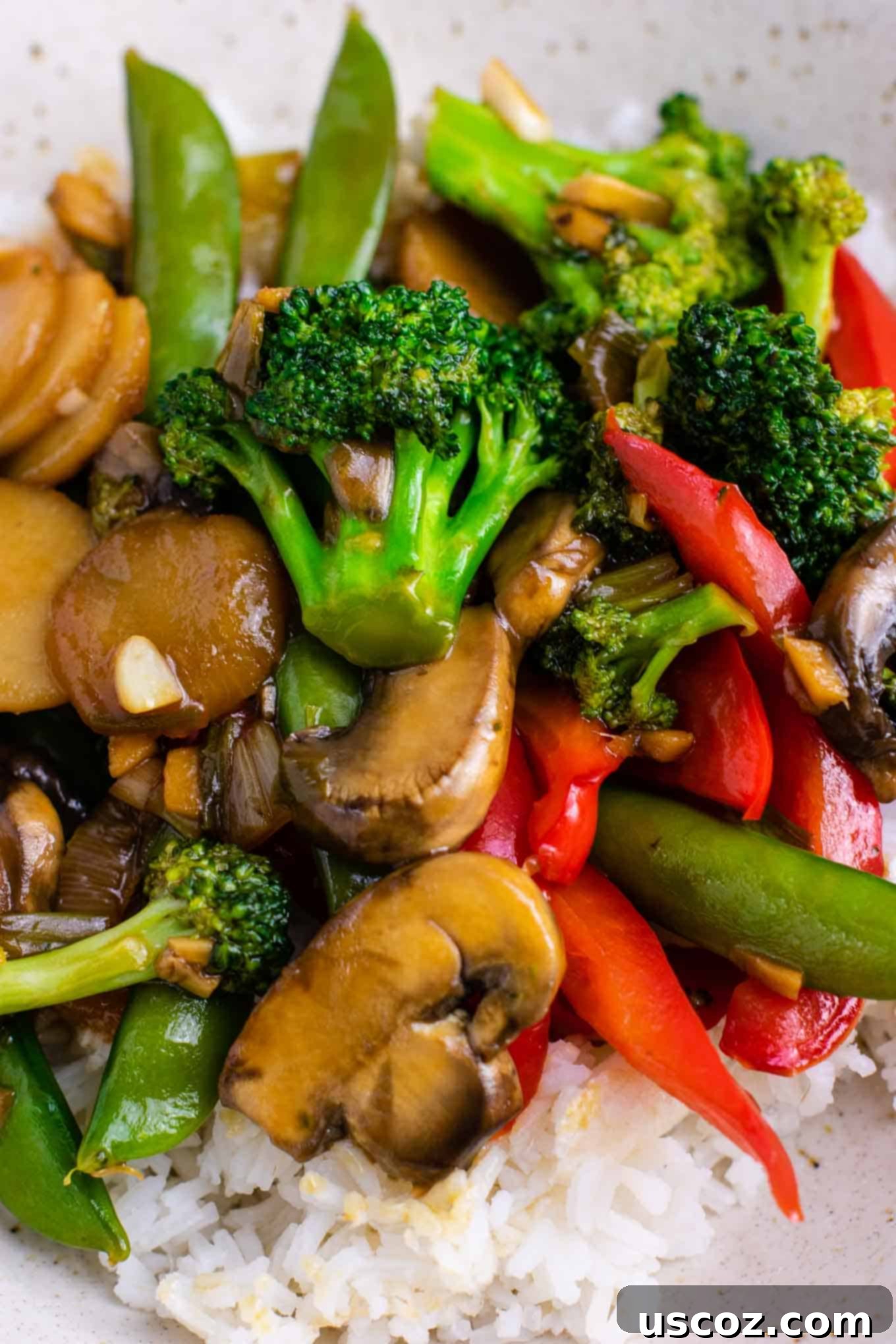
More Delicious Stir Fry Recipes You’ll Love
If you’re a fan of quick, flavorful, and versatile stir-fries, be sure to explore these other fantastic recipes:
- Asian Mushroom Ramen Noodles
- Easy Cabbage Stir Fry
- Broccoli with Garlic Sauce
- Flavorful Ramen Noodle Stir Fry
- Garlic Tofu Broccoli Skillet (Broccoli Tofu Stir Fry)
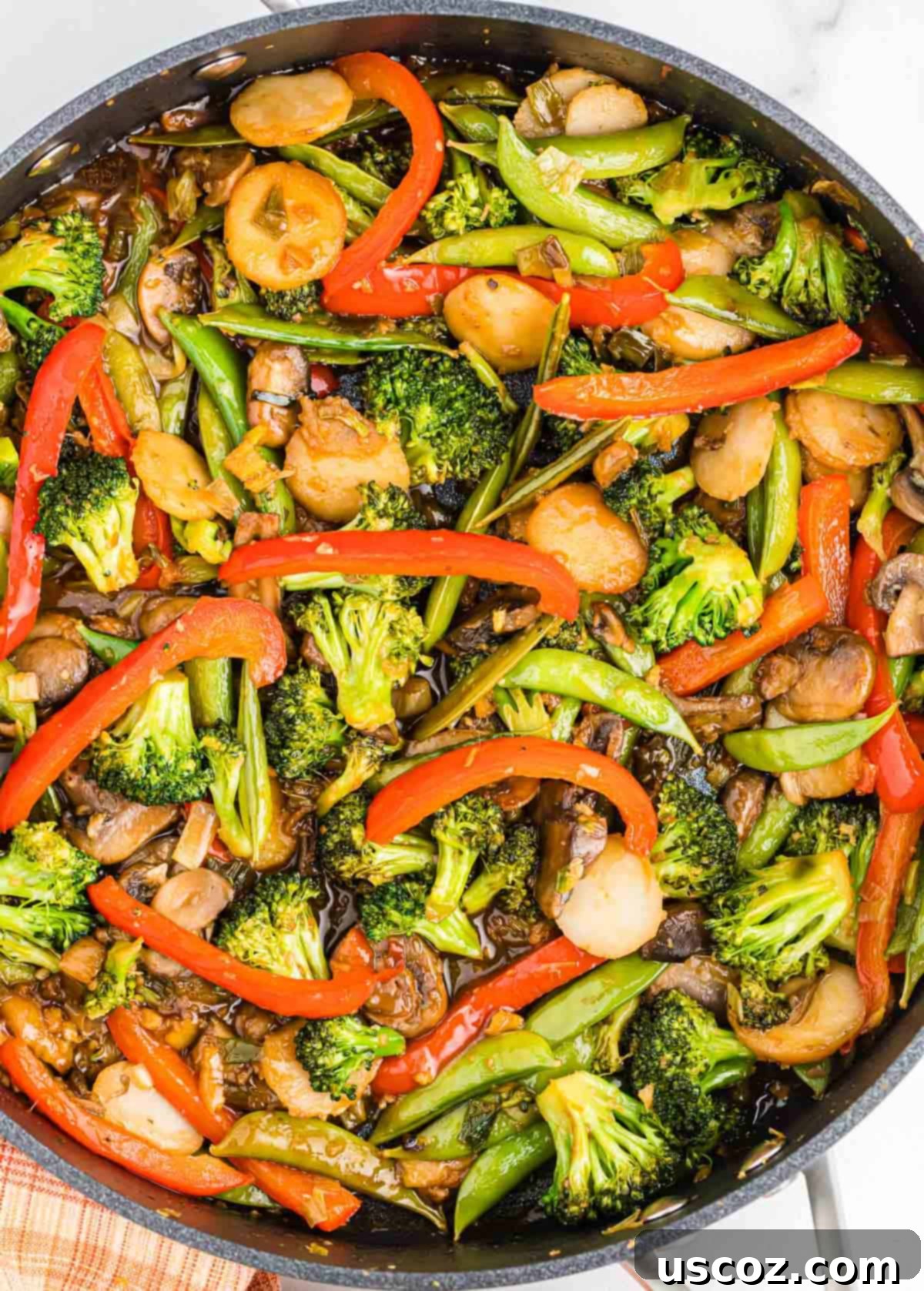
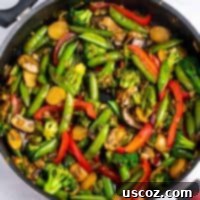
Stir Fry Veggies
These easy stir fry veggies with homemade garlic sauce are absolutely delicious!
Ingredients
- 1 tablespoon sesame oil
- 8 oz sliced water chestnuts
- 8 oz sugar snap peas
- 8 oz sliced mushrooms
- 1 red bell pepper, sliced
- 1 bunch of green onions, sliced (around 1 1/2 cups worth)
- 4 cups fresh broccoli florets
- 12 cloves of garlic, minced
- 1/4 cup minced fresh ginger
- 1 batch homemade stir fry sauce
- White or brown rice, for serving (optional)
- Noodles of choice, for serving (optional)
Instructions
- Heat a large skillet or jumbo cooker to medium-high heat with 1 tablespoon of sesame oil.
- Add the water chestnuts, sugar snap peas, mushrooms, bell pepper, green onions, broccoli, garlic, and ginger to the pan.
- Stir fry the vegetables for 20 – 25 minutes, stirring often, until most of the liquid evaporates and vegetables are cooked but not too soft (tender-crisp).
- In a separate jar or bowl, shake or whisk together a batch of the homemade stir fry sauce.
- Pour the stir fry sauce over the vegetables and cook for an additional 3 – 5 minutes, stirring frequently, until the sauce thickens and coats the vegetables beautifully.
- Serve alone or over white rice, brown rice, or noodles of choice for a complete and delicious meal.
Video
Notes
- If serving with rice, you may need to salt the rice according to your taste preferences, as the stir fry sauce is already quite flavorful.
- For a gluten-free option, ensure your soy sauce is gluten-free tamari.
- For added protein, consider adding pre-cooked tofu cubes, chickpeas, or thinly sliced chicken breast during the last 5-10 minutes of vegetable cooking, or cook separately first.
Nutrition
Carbohydrates: 29g,
Protein: 7g,
Fat: 4g,
Saturated Fat: 1g,
Polyunsaturated Fat: 3g,
Sodium: 101mg,
Fiber: 8g,
Sugar: 6g
